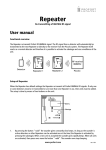Download PRELIMINARY USER MANUAL
Transcript
K R A ME R E LE CT R O N IC S L TD . PRELIMINARY USER MANUAL MODEL: PA-150 70V/100V 50W Power Amplifier P/N: 2900-300406 Rev 1 Contents 1 Introduction 1 2 2.1 2.2 2.3 3 Getting Started Achieving the Best Performance Safety Instructions Recycling Kramer Products Overview 2 2 2 3 4 4 Defining the PA-150 50W Power Amplifier 5 5 5.1 5.2 5.3 5.4 6 6.1 Connecting the PA-150 Connecting the PA-150 Wiring the Inputs Connecting Speakers Connecting the Remote Volume Control Operating the PA-150 Indicators 6 6 7 9 10 11 11 7 Troubleshooting 12 8 Technical Specifications 13 Figures Figure 1: PA-150 50W Power Amplifier Rear Panel Figure 2: Connecting the PA-150 50W Power Amplifier Figure 3: Connecting a Balanced XLR Input Figure 4: Connecting a Balanced 6.5mm Phone Jack Figure 5: Connecting an unbalanced RCA Input Figure 6: Connecting an unbalanced 6.5mm Phone Jack Figure 7: Connecting One or Multiple Speakers to the PA-150 (100V) Figure 8: Connecting One or Multiple Speakers to the PA-150 (70V) Figure 9: Connecting the Remote Volume Control 5 6 7 8 8 8 9 10 10 PA-150 – Contents i 1 Introduction Welcome to Kramer Electronics! Since 1981, Kramer Electronics has been providing a world of unique, creative, and affordable solutions to the vast range of problems that confront the video, audio, presentation, and broadcasting professional on a daily basis. In recent years, we have redesigned and upgraded most of our line, making the best even better! Our 1,000-plus different models now appear in 14 groups that are clearly defined by function: GROUP 1: Distribution Amplifiers; GROUP 2: Switchers and Matrix Switchers; GROUP 3: Control Systems; GROUP 4: Format/Standards Converters; GROUP 5: Range Extenders and Repeaters; GROUP 6: Specialty AV Products; GROUP 7: Scan Converters and Scalers; GROUP 8: Cables and Connectors; GROUP 9: Room Connectivity; GROUP 10: Accessories and Rack Adapters and GROUP 11: Sierra Products; GROUP 12: Digital Signage; and GROUP 13: Audio, and GROUP 14: Collaboration. Congratulations on purchasing your Kramer PA-150 50W Power Amplifier, which is ideal for the following typical applications: Boardrooms Classrooms Hospitality Transportation Retail Entertainment Houses of worship PA-150 - Introduction 1 2 Getting Started We recommend that you: Unpack the equipment carefully and save the original box and packaging materials for possible future shipment i 2.1 Review the contents of this user manual Go to http://www.kramerav.com/downloads/PA-150 to check for up-to-date user manuals, application programs, and to check if firmware upgrades are available (where appropriate). Achieving the Best Performance To achieve the best performance: Use only good quality connection cables (we recommend Kramer highperformance, high-resolution cables) to avoid interference, deterioration in signal quality due to poor matching, and elevated noise levels (often associated with low quality cables) Do not secure the cables in tight bundles or roll the slack into tight coils Avoid interference from neighboring electrical appliances that may adversely influence signal quality Position your Kramer PA-150 away from moisture, excessive sunlight and dust ! 2.2 Safety Instructions ! 2 This equipment is to be used only inside a building. It may only be connected to other equipment that is installed inside a building. Caution: There are no operator serviceable parts inside the unit Warning: Use only the Kramer Electronics power supply that is provided with the unit Warning: Disconnect the power and unplug the unit from the wall before installing PA-150 - Getting Started 2.3 Recycling Kramer Products The Waste Electrical and Electronic Equipment (WEEE) Directive 2002/96/EC aims to reduce the amount of WEEE sent for disposal to landfill or incineration by requiring it to be collected and recycled. To comply with the WEEE Directive, Kramer Electronics has made arrangements with the European Advanced Recycling Network (EARN) and will cover any costs of treatment, recycling and recovery of waste Kramer Electronics branded equipment on arrival at the EARN facility. For details of Kramer’s recycling arrangements in your particular country go to our recycling pages at http://www.kramerelectronics.com/support/recycling/. PA-150 - Getting Started 3 3 Overview The Kramer PA-150 is a high−performance mono, audio power amplifier for balanced signals that can output 50W of audio into 70V or 100V speaker systems. The PA-150 50W Power Amplifier features: 4 Output power 50 W into one channel 70V or 100V amplification Line-level, balanced input Input level sensitivity adjustment Remote volume and mute control PA-150 - Overview 4 Defining the PA-150 50W Power Amplifier Figure 1: PA-150 50W Power Amplifier Rear Panel # Feature Function 1 INPUT 3-pin Terminal Block Connect to the line-level, balanced, stereo audio source, (for example, a media player), see Section 5.2.1 LEVEL Trimmer Turn clockwise to increase the amplitude of the input signal; turn anticlockwise to decrease the level 3 REMOTE 4-pin Terminal Block Connect to the remote, 10v volume control, (for example, the W-LM) and mute-switch, (see Section 5.4) 4 ON LED Lights blur when the device receives power 5 SIGNAL LED Lights green when there is an input signal present 6 CLIP LED Lights red when the signal clips on the output 7 POWER 2-pin Terminal Block Connect to the power supply provided, (see Section 5.4) 8 SPEAKER 3-pin Terminal Block Connect to either the 100V speaker chain or to the 70V speaker chain, (see Section 5.3). Note: Only one of the outputs can be used at a time 2 PA-150 - Defining the PA-150 50W Power Amplifier 5 5 Connecting the PA-150 This chapter comprises the following sections: 5.1 Connecting the PA-150 (see Section 5.1) Wiring the inputs (see Section 5.2) Connecting speakers (see Section 5.3) Connecting the Remote Volume Control (see Section 5.4) Connecting the PA-150 i Always switch off the power to each device before connecting it to your PA-150. After connecting your PA-150, connect its power and then switch on the power to each device. Figure 2: Connecting the PA-150 50W Power Amplifier 6 PA-150 - Connecting the PA-150 To connect the PA-150 as illustrated in the example in Figure 2: 1. Connect a balanced audio source, (for example, a PC) to the INPUT 3-pin terminal block. 2. Connect the speaker(s) to the SPEAKER OUT 3-pin terminal block, (see Section 5.3). 3. Connect a remote volume control, (for example, the W-LM) to the Remote 4-pin terminal block, (pins +V, LEVEL, and GND). 4. Connect a remote, momentary mute-switch to the Remote 4-pin terminal block, (pins Mute and GND). 5. Connect the power adapter to the PA-150 and plug the power adapter into the mains power supply. 5.2 Wiring the Inputs Your PA-150 is provided with a 3-pin terminal block for its input connection. This connector can accept either a balanced or an unbalanced signal however, some modifications must be made for an unbalanced connection. 5.2.1 Wiring Balanced Inputs When using a balanced input source and connector, you must ensure that the hot, cold, and ground pins of the connector are matched up to the +, –, and ground pins of the PA-150 terminal block connector respectively. The following diagrams illustrate how to connect standard XLR and TRS connectors. Figure 3: Connecting a Balanced XLR Input PA-150 - Connecting the PA-150 7 Figure 4: Connecting a Balanced 6.5mm Phone Jack 5.2.2 Wiring Unbalanced Inputs When using an unbalanced input source, a jumper must be added between the negative (–) and ground terminals. The unbalanced source is connected to the positive (+) and ground terminals. Note: A jumper is required for connecting an unbalanced input. Figure 5: Connecting an unbalanced RCA Input Figure 6: Connecting an unbalanced 6.5mm Phone Jack 8 PA-150 - Connecting the PA-150 5.3 Connecting Speakers You can connect one or more 70V or 100V speakers to the PA-150. The following table details the cable requirements for connecting the PA-150 to speakers. Distance (ft.) Wire Gauge (AWG) Up to 500 22 500 to 1000 20 Over 1000 18 Note: Only one of the outputs can be used at a time. When connecting more than one speaker they must be connected in parallel as shown in Figure 7 (100V speakers) and Figure 8 (70V speakers). Figure 7: Connecting One or Multiple Speakers to the PA-150 (100V) PA-150 - Connecting the PA-150 9 Figure 8: Connecting One or Multiple Speakers to the PA-150 (70V) 5.4 Connecting the Remote Volume Control The following diagram illustrates how to connect the W-LM Remote Volume Control to the PA-150. Note: The remote volume control overrides the level control on the rear of the device. Figure 9: Connecting the Remote Volume Control 10 PA-150 - Connecting the PA-150 6 6.1 Operating the PA-150 Indicators The following table details the LED indicators. Label Color Description SIGNAL Green There is an input signal present ON Blue The device is receiving power CLIP Red The input signal is being clipped PA-150 - Operating the PA-150 11 7 Troubleshooting The PWR LED does not light. Check that the power adapter is plugged into a functioning outlet and that the adapter is correctly connected to the PA-150. No output is heard from the speakers; the CLIP LED lights. Check that the level control and remote volume control are not turned down. Check that the input and output connections are secure. Insure that the SIG LED lights to denote a signal. If there is no signal detected, check the signal source and that the level controls are set high enough. Amplifier overheats and/or shuts down. Check the CLIP LED on the rear of the amplifier to see if the signal is overdriving (the signal light flashes red frequently). Overdriving the amplifier for extended periods can cause a thermal shutdown. Output sound is distorted or cracking. Check all cables for damage or loose connections and reduce the gain on the input signal at the mixer or preamp level. Replace the cables and speakers temporarily to see if this resolves the problem. 12 PA-150 - Troubleshooting 8 Technical Specifications INPUTS: 1 INPUT, balanced, on a 3-pin terminal block connector OUTPUTS: 1 OUTPUT 100V/70V on a 3-pin terminal block connector POWER OUTPUT: 50W x 1 @70V/100V FREQUENCY RESPONSE: 100Hz (0dB) to 20kHz (–3dB) POWER BANDWIDTH: 80Hz to 30kHz (±3dB) THD+N: <0.1% SIGNAL to NOISE RATIO: >80dB REMOTE VOLUME CONTROL: 0-10V DC, 4-pin Block INPUT SENSITIVITY: 0.5V (–3dBV) STANDARD VOLTAGE GAIN: 150X (43dB) @70V INPUT IMPEDANCE: (Balance/Unbalanced) 20kΩ/10kΩ INDICATOR LEDs: On, Signal, Clip POWER CONSUMPTION: 48V DC, 1.3A CLASS: D OPERATING TEMPERATURE: 0° to +40°C (32° to 104°F) STORAGE TEMPERATURE: –40° to +70°C (–40° to 158°F) HUMIDITY: 10% to 90%, RHL non-condensing COOLING: Convection ENCLOSURE TYPE: Aluminium chassis PLENUM RATING: UL 2043 Approved DIMENSIONS: 15.2cm x 10.2cm x 3.2cm (6.0" x 4.0" x 1.25") W, D, H WEIGHT: 0.46kg (1.01bs) approx. SHIPPING WEIGHT: 1.06kg (2.34lbs) approx. INCLUDED ACCESSORIES: Power supply 48V DC Specifications are subject to change without notice at http://www.kramerelectronics.com PA-150 - Technical Specifications 13 For the latest information on our products and a list of Kramer distributors, visit our Web site where updates to this user manual may be found. We welcome your questions, comments, and feedback. Web site: www.kramerelectronics.com E-mail: [email protected] ! P/N: SAFETY WARNING Disconnect the unit from the power supply before opening and servicing 2900- 300406 Rev: 1


























